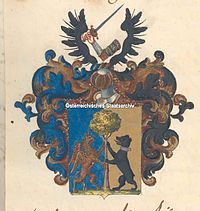- Christoph von Beezen
-
Christoph Beetz (May 1, 1670, Swedish Pomerania – April 18, 1746, Stralsund) was ennobled by Emperor Charles VI in Vienna, Austria on 27 January 1734 as "Beez von Beezen" (Beetz von Beetzen) after receiving a heritable membership of the old class of the Holy Roman Empire (higher nobility). His military career is highlighted by his military career from 1690 and his final appointment as Swedish Platz-Major and Stabs-Major of the military garrison in Stralsund. He was ranked with the same duties as a Stadt-General. His 1746 portrait still graces the interior of Saint Mary's Church, Stralsund, Germany (German: Kirche St. Marien zu Stralsund) where he is buried.According to the letters patent of January 27, 1734, now in the Österreichisches Staatsarchiv in Vienna, the nobility is inherited by "all his present and future legitimate posterity, and their heirs' heirs, men and women in descending line, in infinity" ('Ihn sambt allen seinem jezigen und künftigen ehelichen Leibs-Erben und derenselben Erbens-Erben, Mann- und Weibs-Personen, absteigenden Stammens'). According to Codex Austriacus (ed. Herrenleben, S.G., Wien 1748, pars III, Suppl. I, 1720, page 953, 954) both daughters and sons inherited in Austria after 1720, so the reference "all his present and future legitimate posterity, and their heirs' heirs" refer, according to Austrian law at the time, to both men and women when the letters patent was issued in 1734. This was also understood and underlined by the addition "men and women in descending line in infinity". This pattern for hereditary nobility is called 'cognatic succession'.
Other examples of cognatic succession for both male and female descendants are the letters patent of nobility issued by Charles VII in December 1429 to Jehanne d'Arc and all her descendants; as well as the title Baron (or Count) Arundell of Wardour according to the letters patent issued by Rudolf II in Prague December 14, 1595 for Thomas Arundell and all his descendants, men as well as women. The more common pattern for hereditary nobility, when only men can forward nobility to their children, is called agnatic succession.
Family from Germany, Sweden, Norway, etc.
Christoph Beetz’ parents and grandparents were also famous and the Emperor’s close employees. Some of his relatives held office in the Swedish state. Christoph Beetz was one of the very famous from the Beetz family. He was married to Anna Sofia from Germany and had two sons, Johan Henrik von Beetzen (born in Stralsund about 1698) and Karl Joakim von Beetzen (born in Stralsund, November 1698). Karl Joakim was married to Anna Helena Giers (born 12 January 1707 in Gøteborg) from the famous Giers family from Sweden–the family has a Russian branch related to the Russian Foreign Minister of 13 years, Nicholas de Giers–and a family branch from the Southern part of England. A member from the large noble family tree is the famous Hans Henric von Essen.
The Beetzen family is today mostly known from Sweden, but there are also Norwegian and German descendants.
Knights through centuries
Christoph von Beezen's ancestors included nobles and knights. It was on this basis that the noble letter was accepted for the higher nobility. The emperor and the king based their power from the old days on rich landowners who were able to develop a military army. This can be read about at the Teutonic Knights. In Christoph von Beezen's noble letter his properties are mentioned, and the coat of arms could be used in this context.
External links
- List of German aristocratic names in Germany.
- Noble families *[1] in Swedish
- Saint Mary's Church website in Stralsund.
- History The Holy Roman Empire
- History of Sweden
- [2] [3] Heraldry in Europe
- no:Christoph von Beetzen A 'von Beezen' page in Norwegian
- Noble Registry The Holy Roman Empire
Categories:- 1670 births
- 1746 deaths
- German nobility
- People from Swedish Pomerania
Wikimedia Foundation. 2010.


